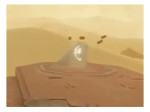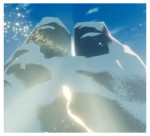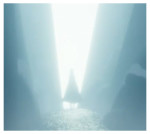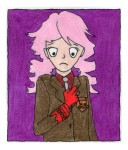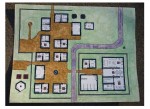Wed 2 Oct 2013
Journey: The Meaning of the Dream
Posted by laup under Gameplay, Meditations, Organic Interocitor, Playtime, Supernal Diver, Transmutation
Comments Off on Journey: The Meaning of the Dream
Like the previous post, this exploration is for people who have played or studied the Journey video game on the PS3. Again, if you don’t know what this video game is about, check out the wiki article here.
Spoilers are a-comin’ in, so if you want to avoid major reveals then take the tape out now and hit the road, Jack.
One of the elements of Journey that I’ve been rolling over in my thoughts is the cutscene at the beginning of the game. It sets the stage for the game by showing the player a number of images that I believe shed illumination on the game’s overall narrative.
The game takes an open-ended approach to the meaning of the game, and I think that should still be kept in mind. My ideas do not negate yours.
However, as I mentioned in my last post when you make certain kinds of symbolic decisions you can’t help but assign them some structure. Piece by general piece, you narrow down the possibilities.
As before, I’m going to break it down for you.
The first image we are shown is a shift from white light to sand. This is incredibly significant.

It bridges the white light at the end of the game with the beginning and it shows us how we rise from the earth to become self aware. We grow in consciousness to an awareness of who we are. This also has ties to how we move out of the unredeemed darkness into a growing vision of who we are.
Right off the bat we have an image showing us that the theme of the game is about raising our consciousness.
The next image we are presented with is the sun over the horizon. Is this a sunrise or a sunset?
Regardless, the time between light and darkness is always the “in-between” time. The moment of greatest danger, the time when the barriers between worlds are weakest and things can pass between existences.
Is this the dawning of daylight and an emergence from darkness? Is this the approach of the darkness and the descent into the unknown? Maybe both, or maybe the outcome is in doubt. This is a time of transition.
Close up to a hill where the sun shines bright. We can see what will later be revealed as the gravestones at the start of the game.
This continues the cutscene’s progression. It means something has changed. Since the sun is higher here than in the previous scene, it means daylight is coming. Illumination has increased and we can now focus on specifics, rather than muddle about in the darkness of grays and indistinct shapes.
What has changed? We don’t know. But time is passing and an idea is forming.
The next scene is a large grouping of gravestones. Where as we were contemplating an individual, or two people, now we move into the collective realm.
Look at all the lonely people. All the dead, unredeemed people. This is a sorrow. All is desert. All is wasteland. There is no sign of life, only the passage of time. The people have lost their way.
Above, in the sky, a shooting star flies through the heavens.
This is God, asking “Who is there?” Calling to us. Showing his signs. It is not a blue sky, however. It too, is lifeless. Heaven is also a wasteland.
You might ask, how can God not know the answer to his question? God knows, but like us God must pretend not to know so that we can discover the greater purpose together. God needs our help even though God doesn’t need it.
The next scene is also a sorrow. God’s call streaks through the sky above the landscape of gravestones, yet goes unheeded.
There is a gap between God and the people. Heaven and earth do not meet. God and the people have lost their way, and there is no life. Or perhaps there is no authentic life. We are all living a phony life that is a shadow of what we might know.
The next scene is a flying through the desert.
Who is flying? You are. This is a premonition of what you will discover in the game—both through moments of small and gradual discovery, and through great moments of inspiration. We are leaving the collective problem here and shifting to the personal.
The focus is zeroing in on you—the player—and the journey you will take.
It should be pointed out that in dreams (and this is indeed a dream) flying means spiritual development. This is entirely appropriate given what you will be doing in the game itself.
Then, you awaken from the dream.
This image is very important. You rise from the earth (because you are mortal), but your head touches the sky. You will be the bridge between heaven and earth. You will redeem the great wrong that afflicts the world.
Contemplate that image, the cloud over your head like a halo. You have heard the call of God. You may not understand it yet, you may not even be able to answer God’s question….”Who is there?”
However, now there is hope. If the people were alive they would rejoice.
The next scene pulls back. You were meditating (an action you can take in the game).
This is appropriate. You were engaged in an attempt to understand or commune with the state of the world. This opened your heart and mind to the call of God.
You stand up, realizing that there is a great task needing to be done. This is the true beginning of the game.
But what is this great task? You are to atone for the sins of the past and become one with God. This is exemplified in your growing relation to your Self. That is, the part of you that is both mortal and one with the divinity, as opposed to the self, who imagines itself as mortal and separate from on high.
This scene from later in the game explains a great deal.
You and the Self are one. You and God are one. This must be re-discovered through atonement. The Journey is your quest for atonement and the realization of the Self.
One of the first wonders you encounter is the glowing symbol surrounded by cloth strips (spirits).
This is holy ground. This is a place where another person heard the call, just as you did. They began their journey here. Now you benefit from this holy place by increasing your awareness of your spiritual connection to God.
This is where your scarf first appears. If you look closely at the World card in the tarot, you will see the evolved Self is naked, but adorned by a scarf. A scarf is a symbol of the spirit flowing free.
This marks the beginning of your spiritual evolution. You will find other symbols along the way and your scarf will grow in size.
Later on you witness a symbol landing in a deserted ruin.
This reinforces the idea that the call of God (shown in the dream flying over the earth) lands where a person hears the call. Person by person a connection is being rebuilt.
Indeed, at the end of the game it is shown that a symbol lands where you first awakened.
You have made your mark for others to follow. The world is changing for the better with every person who hears the call.
In the lighthouse you are faced with several glyphs that display your journey.
This is a gathering of all your scattered piece into a whole. There is an unconscious sequence, symbolized by the out of order glyphs. However, the fact that you have all the pieces means you will fit them together in the final challenge.
Near the end, you are faced with a gargantuan figure. Some believe them to be sages, angels, or ancestors. I believe this is your Self, regarding you.
As you grow in knowledge and experience, your Self appears larger each time. Your true being is so enormous! It draws me back to an issue of the Doctor Strange comic book in which the hero confronts death. You will be required to grow in order to fill the mammoth form you inhabit.
Seriously. Did you never suspect that your true being is much greater than the form you seem to inhabit?
Your mortal adventurer is faced with this realization in the wide panorama of their journey.
The big picture is big. You are bringing into existence your Self through the trials and wonders of your journey.
This is the hard part. Only our mortal striving can awaken in ourselves the part of our being that is one with God. It’s one thing to hear the call, to know it is there. To understand it is a whole other thing.
I talk about the defeat that is necessary to ascend in the previous post. To reach the summit and the final realization requires a beat down. A humbling.
Yet if you do not give up, you reach your goal.
At the top, your scarf retracts. You don’t need it anymore. Your Self is one with God, as you are coming to realize.
Dumbo no longer needs the feather to fly because he could always fly already!
You walk into the white light where you will encounter the experience that will lead to the realization of the Self. Something wonderful will happen.
You pass into the final gap between the two poles of life and death. This is where you will fulfill the dream at the beginning of the game.
What does that mean?
Go back to the very first story-stone cutscene in the game, where you were shown what the mountain does. Life will return to the wasteland. The birds (the animals) and the plants will return. The people will appear (they will revive).
Do you see how important it is that you have gone on the journey?









